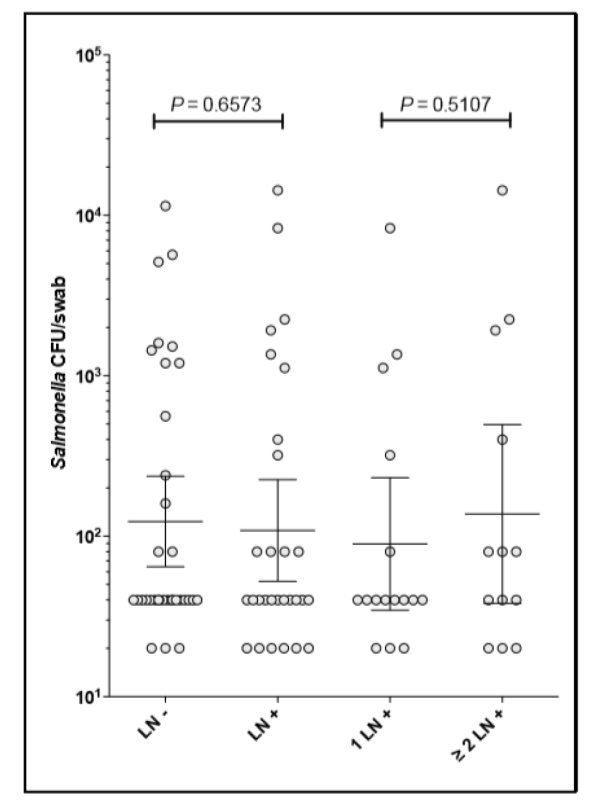Project Summary
Examination of Potential Predictors of Salmonella enterica Contamination in Cattle Feedlot Environments
- Principle Investigator(s):
- Dayna M. Brichta-Harhay, Terrance M. Arthur, John W. Schmidt, Rong Wang, Norasak Kalchayanand, Mick Bosilevac, Tom Edrington, Guy Loneragan, Tommy Wheeler
- Institution(s):
- USDA, ARS, U.S. Meat Animal Research Center (USMARC)
- Completion Date:
- May 2013
Background
Bovine peripheral lymph nodes (LNs) have been identified as a potential source of human exposure to Salmonella enterica, when adipose trim containing contaminated LNs is incorporated into ground beef. Results of recent studies suggest that excessively high levels of Salmonella in cattle environments and on cattle hides provide the opportunity for Salmonella to gain entry to bovine peripheral LNs via transdermal abrasions such as insect bites and wounds. Once located within the bovine lymphatic system, many Salmonella have the ability to persist or even thrive, without obvious negative impact on cattle health and performance. Furthermore, at harvest Salmonella located within bovine tissues are protected from current carcass antimicrobial interventions. Thus, pre-harvest interventions will likely be needed to circumvent this point of entry for Salmonella into the human food chain. In order to evaluate the efficacy of pre-harvest interventions it will be necessary to identify reliable methods for monitoring Salmonella prevalence and levels in feedlot environments. Thus, the objective of the research described here was to determine if a reliable “predictor” or “environmental marker” could be identified, that could be used to determine Salmonella prevalence in a given feedlot setting and then further, for a given cohort of cattle, to examine the possible correlation between the level of environmental Salmonella contamination, Salmonella fecal shedding status, and the prevalence of Salmonella in peripheral lymph nodes of cattle at harvest.
The objectives of the study were to: 1) identify a “predictor” or “environmental marker” that can be used to determine Salmonella prevalence in feedlot environments and examine the efficacy for the predicting Salmonella prevalence in peripheral lymph nodes; and 2) for a given cohort of cattle, examine the correlation between environmental Salmonella contamination, Salmonella fecal shedding status, and prevalence of Salmonella in peripheral lymph nodes.
Methodology
Samples were collected from three feedlots, one in BIFSCo Region 3 and two in Region 5 (Fig. 1). Hide, fecal and environmental samples were collected in October 2012, January 2013 and May 2013 in Region 3, while those in Region 5 were collected in May and June 2013.
Matched hide swab and fecal swab samples were collected from 405 cattle in Region 3 and from 95 cattle in Region 5. On average, 24% of cattle per pen were sampled from a total of 10 pens, and average pen size was 224 head. Hide and fecal samples were collected from cattle restrained in a squeeze chute, as they were being processed for growth promoter re-implant (approximately 75 days post arrival at the feed yard). Environmental samples from 5 pens per yard, including pen floor surface material, water tank, feed, and flies, also were collected from each of the three participating yards. Approximately 90 days post re-implant, cattle were shipped to a commercial abattoir for harvest and a subset of cattle sampled at re-implant in October 2012 and January 2013, were selected for lymph node and fecal swab collection. Samples were analyzed for Salmonella prevalence and level. LN samples from a third set of cattle (n = 15 head) originating from Region 3 were collected in March 2013. For each carcass, six lymph nodes were collected, three from each carcass half, including the superficial cervical, subiliac, and popliteal.
Findings
Results indicate that Salmonella fecal shedding status is not directly related to LN contamination within a given animal. Instead, peripheral LN contamination appears to be related to the percent of Salmonella super shedders present in a pen, and the resultant hide contamination levels of cohorts within that pen (Table 1 and Figure 2).
Enumerable levels of Salmonella in tank water and measurable prevalence in feed are potential indicators of aberrantly high levels of Salmonella in a given feedlot. While Salmonella could be detected on hides, in feces, and in pen surface material in both Regions 3 and 5, only in Region 3 was Salmonella found present in feed and enumerable in water samples (Table 1).
Implications
The data collected in this study suggest that aberrantly high levels of Salmonella contamination on cattle hides (defined here as hides contaminated at ≥ 103 CFU/100 cm2) are directly related to peripheral lymph node contamination with Salmonella. Analysis of feedlot environmental samples including surface material, tank water, feed and flies, suggests that enumerable levels of Salmonella in tank water and measurable prevalence in feed are possible indicators of aberrantly high levels of Salmonella in a feedlot. Given the ease of collection and processing of these sample types, they may represent good candidates for reliable “predictors” of feedlots that could benefit from a Salmonella intervention.

Figure 1. Map of BIFSCo monitoring regions in the U.S.

Figure 2. Comparison of Salmonella fecal shedding as measured by fecal swab at harvest, and peripheral lymph node (LN) contamination. Shedding levels detected for carcasses negative for Salmonella contamination (LN -) (n = 34); carcasses positive for LN contamination (LN +) (n = 29); carcasses found with one LN positive (1 LN +) (n = 16); and carcasses found with more than one LN positive (≥ 2 LN +) (n = 13).
Table 1. Summary of Salmonella prevalence and levels in hide, fecal and environmental samples, in settings with high (BIFSCo Region 3), moderate (Region 5), or low (Region 5) levels of Salmonella. No SF indicates that no stable flies were present on traps; Aug/Sept 2013* - indicates time period that sample collection is anticipated to occur; Month superscripts indicate the month that cattle went to harvest and LN samples were collected; - indicates that environmental samples were not able to be collected in that time period.
